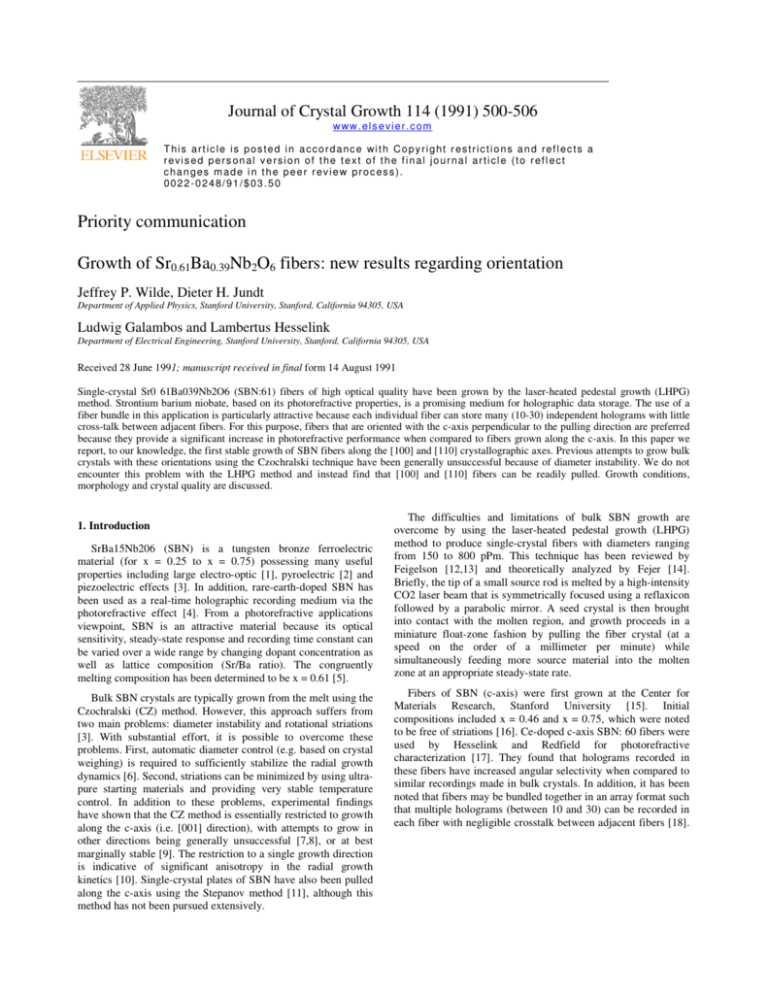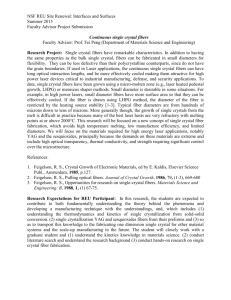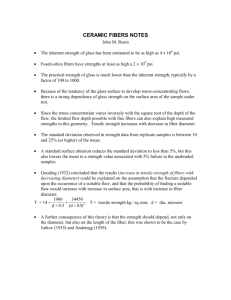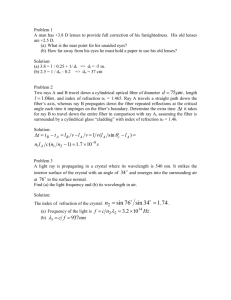Priority communication Growth of Sr0.61Ba0.39Nb2O6 fibers: new
advertisement

Journal of Crystal Growth 114 (1991) 500-506
www.elsevier.com
T h i s a r t i c l e i s p o s t e d i n a c c o r d a n c e wi t h C o p y r i g h t r e s t r i c t i o n s a n d r e f l e c t s a
revised pers onal ve rsion of the text of the final journal article (to refl ect
chan ges m ade i n the peer review process).
0022-0248/91/$03. 50
Priority communication
Growth of Sr0.61Ba0.39Nb2O6 fibers: new results regarding orientation
Jeffrey P. Wilde, Dieter H. Jundt
Department of Applied Physics, Stanford University, Stanford, California 94305, USA
Ludwig Galambos and Lambertus Hesselink
Department of Electrical Engineering, Stanford University, Stanford, California 94305, USA
Received 28 June 1991; manuscript received in final form 14 August 1991
Single-crystal Sr0 61Ba039Nb2O6 (SBN:61) fibers of high optical quality have been grown by the laser-heated pedestal growth (LHPG)
method. Strontium barium niobate, based on its photorefractive properties, is a promising medium for holographic data storage. The use of a
fiber bundle in this application is particularly attractive because each individual fiber can store many (10-30) independent holograms with little
cross-talk between adjacent fibers. For this purpose, fibers that are oriented with the c-axis perpendicular to the pulling direction are preferred
because they provide a significant increase in photorefractive performance when compared to fibers grown along the c-axis. In this paper we
report, to our knowledge, the first stable growth of SBN fibers along the [100] and [110] crystallographic axes. Previous attempts to grow bulk
crystals with these orientations using the Czochralski technique have been generally unsuccessful because of diameter instability. We do not
encounter this problem with the LHPG method and instead find that [100] and [110] fibers can be readily pulled. Growth conditions,
morphology and crystal quality are discussed.
1. Introduction
SrBa15Nb206 (SBN) is a tungsten bronze ferroelectric
material (for x = 0.25 to x = 0.75) possessing many useful
properties including large electro-optic [1], pyroelectric [2] and
piezoelectric effects [3]. In addition, rare-earth-doped SBN has
been used as a real-time holographic recording medium via the
photorefractive effect [4]. From a photorefractive applications
viewpoint, SBN is an attractive material because its optical
sensitivity, steady-state response and recording time constant can
be varied over a wide range by changing dopant concentration as
well as lattice composition (Sr/Ba ratio). The congruently
melting composition has been determined to be x = 0.61 [5].
Bulk SBN crystals are typically grown from the melt using the
Czochralski (CZ) method. However, this approach suffers from
two main problems: diameter instability and rotational striations
[3]. With substantial effort, it is possible to overcome these
problems. First, automatic diameter control (e.g. based on crystal
weighing) is required to sufficiently stabilize the radial growth
dynamics [6]. Second, striations can be minimized by using ultrapure starting materials and providing very stable temperature
control. In addition to these problems, experimental findings
have shown that the CZ method is essentially restricted to growth
along the c-axis (i.e. [001] direction), with attempts to grow in
other directions being generally unsuccessful [7,8], or at best
marginally stable [9]. The restriction to a single growth direction
is indicative of significant anisotropy in the radial growth
kinetics [10]. Single-crystal plates of SBN have also been pulled
along the c-axis using the Stepanov method [11], although this
method has not been pursued extensively.
The difficulties and limitations of bulk SBN growth are
overcome by using the laser-heated pedestal growth (LHPG)
method to produce single-crystal fibers with diameters ranging
from 150 to 800 pPm. This technique has been reviewed by
Feigelson [12,13] and theoretically analyzed by Fejer [14].
Briefly, the tip of a small source rod is melted by a high-intensity
CO2 laser beam that is symmetrically focused using a reflaxicon
followed by a parabolic mirror. A seed crystal is then brought
into contact with the molten region, and growth proceeds in a
miniature float-zone fashion by pulling the fiber crystal (at a
speed on the order of a millimeter per minute) while
simultaneously feeding more source material into the molten
zone at an appropriate steady-state rate.
Fibers of SBN (c-axis) were first grown at the Center for
Materials Research, Stanford University [15]. Initial
compositions included x = 0.46 and x = 0.75, which were noted
to be free of striations [16]. Ce-doped c-axis SBN: 60 fibers were
used by Hesselink and Redfield for photorefractive
characterization [17]. They found that holograms recorded in
these fibers have increased angular selectivity when compared to
similar recordings made in bulk crystals. In addition, it has been
noted that fibers may be bundled together in an array format such
that multiple holograms (between 10 and 30) can be recorded in
each fiber with negligible crosstalk between adjacent fibers [18].
Fig. 1. Transverse cross sections illustrating the various morphologies characteristic of SBN: 61 fiber
growth: (a) c-axis fiber with a 280 jum diameter, (b) [110] fiber with a 455 Am diameter, and (c) [110]
fiber with a 220 /.tm diameter. The diameters measured for(b) and (c) are taken along the c-axis.
This type of an array may prove valuable as part of a highdensity data storage device. Recently, work on the LHPG growth
of SBN has been reported by Yamamoto and Bhalla [9], who also
find that high-quality c-axis fibers can be readily pulled.
Despite significant anisotropy in the growth characteristics of
SBN, we find that high-quality [1001 (i.e. a-axis) and [110]
fibers can be readily pulled using the LHPG method. Both
orientations produce essentially the same results in terms of
growth behavior and fiber morphology. To our knowledge, this is
the first report of stable SBN growth in directions other than the
c-axis. The stability is a consequence of the steep temperature
gradients ('-s 1000 °C/cm) and molten zone confinement
provided by the LHPG method. These intrinsic properties tightly
constrain the location and shape of the freezing interface, an
essential feature in controlling the anisotropic growth kinetics.
Moreover, the LHPG methodcan lead to uniform crystallization
and, when combined with the fact that no crystal rotation is
needed, typically yields striation-free material.
An SBN fiber having the c-axis perpendicular to the fiber axis
is of significant practical importance because it offers a
configuration for obtaining an optimal photorefractive response
(assuming a typical trapping center concentration of
reduction ratio of 0.77. Additional work is ongoing to explore a
broader range of operating conditions with regard to crystal
quality and growth stability. Typically, the length of a fiber is 2-3
cm, a range that is governed by the mechanical pulling apparatus
and the quantity of source material. As-grown SBN fibers,
particularly those with diameters greater than 500 Am,
sometimes exhibit dark regions attributed to excessive oxygen
vacancies. Post annealing treatments are sufficient to convert
these regions into an optically transparent form [23].
The morphology of an SBN fiber depends on its growth
direction, as shown in fig. 1. Growth along the c-axis produces a
circular cross-section (fig. la) which does not, in general, exhibit
the pronounced radial faceting that is characteristic of CZ-grown
boules, although slight faceting is sometimes observed for
diameters larger than 400 Am. Both the [1001 and the [110]
orientation can grow with two possible morphologies. In the first
case (fig. ib), a pair of opposing facets runs along the fiber
surface, while in the second case (fig. ic) these facets transform
into well-defined ridges, similar to those previously observed in
LiNb03 [241. These surface features are located in regions where
the [0101 and [110] axes intersect the fiber perimeter. The facets
and ridges provide a very convenient means for visually
determining the crystallographic orientation.
1016 cm3). To achieve optimum diffraction efficiency, a
transmission hologram is recorded by focusing two separate, but
mutually coherent, optical wavefronts into one end of the fiber
such that the resulting photorefractive grating vector is aligned
with the c-axis, thereby producing a modulation of refractive
index via the large r33 linear electro-optic coefficient. For SBN
:61 at room temperature, r33 235 pm/V and r13 47 pm/V [201.
The fact that a transmission hologram is used is important
because, when compared to a reflection hologram, the lower
spatial frequencies associated with a transmission hologram
allow a much larger space-charge field to develop before
saturation limits arise [21].
2. Experimental findings
The specific LHPG system that we used for the work
discussed in this paper has been described elsewhere [221. Seed
bars with approximate dimensions 0.5 mm x 0.5 mm X 10 mm
were cut from a CZ-grown crystal. The seed orientation was
accurate to within 20 as determined from Laue X-ray diffraction
patterns. Source rods were fabricated from starting materials
consisting of reagent grade SrCO3 and BaCO3 G.T. Baker Co.),
and optical grade Nb2O5 (Cabot Corp.). Stoichiometric
proportions of the powders were combined in a platinum crucible
and melted (1 h at 1550 °C) to ensure thorough mixing. The
melting point of SBN: 61 is approximately 1500°C. After cooling
to room temperature, the reacted polycrystalline material was
removed from the crucible and thoroughly ground into powder
using a mortar and pestle. A pellet was then formed by
isostatically pressing the powder at 20 kpsi, followed by sintering
at 1420'C for 12 h. From this pellet, source rods of dimensions
1.4 mm X 1.4 mm x 15 mm were cut using a high-speed diamond
saw. In order to perform a series of fiber diameter reductions, asgrown fibers were subsequently used for both seeding and source
material.
The results presented here are based on over fifty separate
fiber growth runs. All of the fibers were grown in air using
constant pull and feed rates. The laser power was manually
adjusted prior to growth in order to achieve an appropriate
molten zone shape. Fibers with diameters between 150 and 800
Am could easily be grown using pulling speeds of 1-2 mm/min
and reduction ratios (fiber-to-source diameter ratio) of 0.56-1.0.
Most fibers were grown at a speed of 1.3 mm/min with a
Fig. 2. SEM photographs of a [1101 SBN:61 fiber (765 um
diameter) showing (a) the transition (denoted by a bracket)
between the faceted and ridged morphologies, and (b) a
magnified view of the transition region. The growth proceeded
from left to right.
The morphology of both [1001 and [110] fibers during the
initial stage of growth (the first 5-10mm) is found to be the same
as that of the seed fiber. If a pre-cut seed bar having a square
cross section is used, the initial fiber growth exhibits the faceted
morphology. A transition between the two morphologies can
occur during growth as shown in fig. 2. From fig. 2a it is seen
that the transition is smooth with no apparent change in diameter;
however, we have also observed similar morphological changes
that are accompanied by perturbations in diameter. The specific
cause of the transition is still uncertain, but it may be related to a
change in the temperature gradients at the freezing interface that
affects the shape
3. Fiber quality
The crystal quality of [1001 and [110] SBN fibers, grown at a
given pull velocity, is found to be a strong function of the fiber
diameter. Generally speaking, the quality improves with
decreasing diameter. Examples of the types of defects
encountered for larger diameters, grown at a speed of 1.3
mm/mill, are shown in fig. 3. Two cross sections, one
corresponding to the faceted morphology (fig. 3a) and the other
to the ridged morphology (fig. 3b), were taken from the 765 Am
diameter fiber shown in fig. 2. Before the cross sections were cut
(using a low-speed diamond saw) and polished, this particular
fiber was first annealed at 1100'C and then carefully inspected
under a microscope. It appeared to be defect-free; however, the
optical micrographs in fig. 3 clearly show that after sample
preparation, both morphologies contain cracks associated with an
apparent strain field that runs parallel to the fiber axis. The
faceted morphology (fig. 3a) tends to exhibit a defect structure
that is most pronounced near the facets and often continues
across the entire fiber diameter. The quality is somewhat
improved after the fiber makes a transition to the ridded
morphology (fig. 3b). In this case the defect resembles a core that
is confined to the central portion of the fiber.
source of strain arises simply from differential hermal expansion
of the fiber during growth. Using a surface-cooled semi-infinite
rod model, Brice [25] has calculated the temperature distribution
in a cylindrical crystal of diameter D. Based on this analysis, it is
seen that the axial temperature gradient at the freezing interface
VT scales as D'2 in the small-diameter limit, appropriate for
fibers. Brice [261 has also formulated a relationship between the
axial and radial temperature gradients, from which he shows that
the maximum tensile strain E,flax occurs at the perimeter of the
crystal and is approximately proportional to D32VZT.
Combining this result with the former one, it is seen that εmax~ D.
Thus, as the fiber diameter is reduced, less surface strain is
expected.
A second and potentially more significant source of strain is
related to the occurrence of a faceted freezing interface. A facet
can have lattice constants and segregation coefficients that differ
from the non-faceted portion of the crystal and hence produce
strain, particularly at the edges of the facet. For example, in
bismuth silicon oxide, facet strain corresponds to 20-30% of the
breaking strain [26]. A study by O'Meara [27] shows that
increasing the diameter of fibers of yttrium aluminum garnet can
lead to facet defects that are not present in smaller diameters. A
simple analysis of faceting [28] indicates that the fact area can be
reduced by increasing VT as well as reducing the average radius
of interface curvature, both of which occur as the fiber diameter
is reduced [27]. For SBN fibers, interfacial faceting effects must
be considered as a significant factor in the formation of the
observed defects.
With the LHPG method, the temperature gradients in the
molten zone region are also influenced by the laser beam
focusing arrangement. To this extent, the range of diameters that
can be successfully grown is system dependent. With our
apparatus we find that SBN :61 fibers, grown at a speed of 1.3
mm/min and having diameters less than 300 jum, generally
possess very high optical quality. Both transverse and
longitudinal cross sections are free of any noticeable defects,
including striations, when observed between crossed polarizers
under a microscope. As an aside, it is interesting to note that
when the same starting materials used in this work are used to
grow CZ crystals, severe rotational striations arise [6].
In conclusion, the LHPG method is found to overcome many
of the problems associated with CZ growth of SBN. It allows for
the growth of high-quality [100] and [110] fibers, although
defects that are not present in small-diameter fibers do arise as
the diameter is increased. Very recent results indicate that the
range of possible diameters is also dependent on the growth rate,
with slower rates (e.g. 0.5 mm/mm) producing somewhat higher
quality fibers. The specific nature of the observed defects and
their relation to thefreezing interface shape is currently under
investigation, along with a more complete characterization of the
growth process.
Acknowledgements
Fig:3. Typical defects that can arise in SBN:61 fibers grown
along the [110] axis. Optical transmission micrographs of two
cross sections (approximately 0.5 mm thick) taken from different
regions of the fiber (765 bcm diameter) shown in fig. 2: (a) the
faceted morphology and (b) the ridged morphology. The arrows
indicate the defect areas. The dark regions around the fiber
perimeter, as well as various small bubbles, are artifacts of the
wax-mounting process.
The defect structures are most likely related to the amount of
strain that is introduced into the crystal during growth. Large
strain can cause dislocation formation as well as cracking. One
The authors greatly acknowledge the services of R. Koch, who
provided sample preparation and photography, and R.S.
Feigelson for many helpful discussions as well as a critical
reading of the manuscript. The fibers discussed in this work were
grown on a LHPG system (Ginzton Laboratory, Stanford
University) which was, to a large extent, designed and built by
M.M. Fejer. This work was partially funded by the
Microelectronics and Computer Technology Corporation (MCC)
and Stanford University. One of us (J.P.W.) thanks the NASA
Graduate Awards Program for support.
Note added in proof
Following submission of this paper, an independent report of
a-axis SBN: 60 fiber growth by Sugiyama et al. [291 has
appeared.
References
[1] P.V. Lenzo, E.G. Spencer and A.A. Baliman, Appi. Phys.
Letters 11(1967) 23.
[2] A.M. Glass, J. Appl. Phys. 40 (1969) 4699.
[3] R.R. Neurgaonkar, W.K. Cory and J.R. Oliver, Ferroelectrics
51(1983) 3.
[4] R.R. Neurgaonkar and W.K. Cory, J. Opt. Soc. Am. B 3
(1986) 274.
[5] K. Megumi, N. Nagatsuma, Y. Kashiwada and Y. Furuhata, J.
Mater. Sci. 11 (1976) 1583.
[6] J.P. Wilde, L. Hesselink and R.S. Feigelson, J. Crystal
Growth 113 (1991) 337.
[71 P. Reiche, R. Schalge, J. Bohm and D. Schultze, Kristall und
Technik 15 (1980) 23.
[8] R.R. Neurgaonkar, W.K. Cory, J.R. Oliver, E.J. Sharp, M.J.
Miller, W.W. Clark, III, G.L. Wood and G.J. Salamo,
Mater. Res. Bull. 24 (1989) 589.
[91 A.M. Prokhorov and Y.S. Kuz'minov, Ferroelectric Crystals
for Laser Radiation Control (Hilger, Bristol, 1990) p. 132.
[10] For a fundamental discussion of anisotropic growth, see
W.A. Tiller, The Science of Crystallization: Microscopic
Interfacial Phenomena (Cambridge Univ. Press,
Cambridge, 1991) chs. 2 and 3.
[11] Y.V. Kazakov, Y.S. Kuz'minov, V.V. Osiko and N.M.
Polozkov, Kristallografiya 15 (1984) 576.
[12] R.S. Feigelson, J. Crystal Growth 79 (1986) 669.
[13] R.S. Feigelson, Mater. Res. Soc. Bull. 13 (1988) 47.
[14] M.M. Fejer, PhD Thesis, Stanford University (1986).
[15] Initial work on fiber growth of SBN at Stanford began in
1985 as a collaborative effort between L. Hesselink and
R.S. Feigelson. Contributions were made by W.L. Kway,
F.M. Schellenberg and Y. Huang.
[16] R.S. Feigelson, in: Materials for Non-Linear and ElectroOptics, Inst. Phys. Conf. Set. 103, Part I, Ed. M.H. Lyons
(Inst. Phys., Bristol, 1989) p. 75.
[17] L. Hesselink and S. Redfield, Opt. Letters 13 (1988) 877.
[18] L. Hesselink, Intern. J. Optoelectron. 5 (1990) 103.
[19] J.K. Yamamoto and A.S. Bhalla, Mater. Res. Bull. 24 (1989)
761.
[20] S. Ducharme, J. Feinberg and R.R. Neurgaonkar, IEEE J.
Quantum Electron. QE-23 (1987) 2116.
[21] M.D. Ewbank, R.R. Neurgaonkar, W.K. Cory and J.
Feinberg, J. AppI. Phys. 62 (1987) 374.
[22] M.M. Fejer, J.L. Nightingale, G.A. Magel and R.L. Byer,
Rev. Sci. Instr. 55 (1984) 1791.
[23] J.C. Brice, O.F. Hill, P.A.C. Whiffin and J.A. Wilkinson, J.
Crystal Growth 10 (1971) 133.
[24] Y.S. Luh, R.S. Feigelson, M.M. Fejer and R.L. Byer, J.
Crystal Growth 78 (1986) 135.
[25] J.C. Brice, J. Crystal Growth 2 (1968) 395.
[26] J.C. Brice, J. Crystal Growth 42 (1977) 427.
[27] D.L. O'Meara, Thesis for the Degree of Engineer, Stanford
University (1989).
[28] J.C. Brice, J. Crystal Growth 6 (1970) 205.
[29] Y. Sugiyama, I. Yokohama, K. Kubodera and S. Yagi, IEEE
Photonics Technol. Letters 3 (1991) 744.







